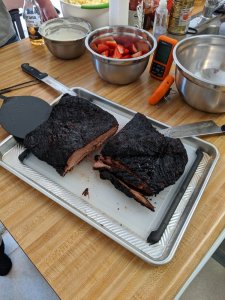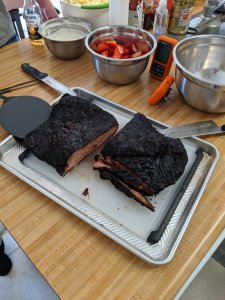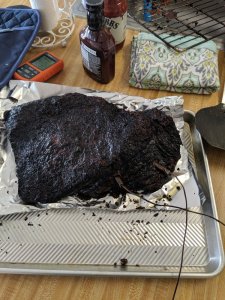When my therm alarm goes off around 203* to alert me, I probe for tenderness and when it passes the tender test then out comes the brisket. if I'm lucky to have it done and about ready to eat and rest for an hour while getting other sides together, I leave it tented with foil or butchers paper to cool down. If hauling it to a different location I foil the meat and use a cooler with crumpled newspaper to fill the void in the cooler vs. towels. That way I don't have to do laundry and newspaper is a great insulator. If I'm not hauling it and ready to eat in an hour, I don't incorporate a mandatory cooler rest for hours as part of the recipe because it passed the tender test and I won't fiddle f... around with it to further delay eating it. If I'm staying home and pull hours ahead of schedule, then I wrap and put back in the turned off smoker with a therm in it. If the temp approaches 140* coming down from 203*, then I turn the smoker back on at 135* or whatever if needing more time to hold at 140*+. Electric smokers are awesome outdoor holding ovens for the holidays when space is limited and a 24 hour smoke costs around $3.00 in electricity.
I don't inject. injected liquid has touched the meat so it has left behind flavor. Every degree has a specific effect on meat which is why we cook by temp and not time so when meat denatures and coagulates to the doneness we are familiar with, the injected liquid comes out with all the other meat juices at those specific temps. It's a one way street with juices coming out as the meat contracts and shrinks expelling it's own juices. If I wants a finishing juice then I add the injection liquid to the pan of drippings . Injection works but I don't fiddle with it.
I use the
AMNPS smoke the whole time and no longer wrap anything except doing a flat brisket which I wrap at 160* IT and pull in the mid upper 190's but may just Sous Vide those from now on till tender after smoking several hours low around 200*. I cook ribs, butts, poultry and whole brisket at 275* with making sure that is max temp not coasting over 275*.
I prefer dry brining (salting meat at room temp for an hour+) before returning to fridge for it to continue brining and then for a pellicle vs. wet brining. I do wet curing with 6.25% nitrite for bacons for simplicity.
Thermoworks has an article on dry brining, describing the hygroscopic effect of salt draws up water/myoglobin to dissolve the salt so the sodium and chloride ions can now pass through cell membranes unlike the larger dissolved molecules of seasonings and sugars. Dry or wet brining isn't osmosis and has the same effect on myosin which keeps it from coagulating during cooking meaning that protein can't contract, keeping more juices in the meat vs. not brining. Salting tenderizes by relaxing and unwinding those tight wad stuck up proteins during the prerest. Wet brining is fine but some describe it as a more diluted meat flavor since the meat soaks in a lot of water and loses some meat juices into the brine.
https://blog.thermoworks.com/turkey/how-to-dry-brine-a-turkey/
After years of wrapping ribs with 2-2-1 or 3-2-1 method and waiting hours for the stall to pass, smoking at the 225* for cuts that go to around 203*, I have gone to absolutely doing nothing till finished and really like the color, taste, texture and bark smoking at 275*. For tender steaks, chops and roasts then I'm closer to 225* or less so it has time in the smoke and around 150* to start for fish, sausage and other cured meats that are safe for a little longer duration at lower temps.








